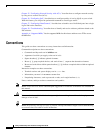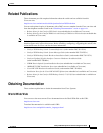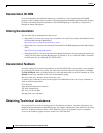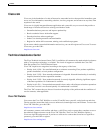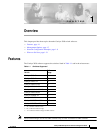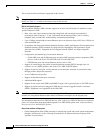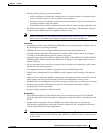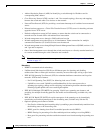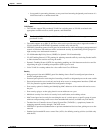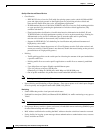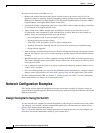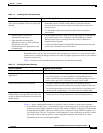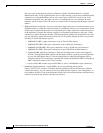
1-3
Catalyst 2950 Desktop Switch Software Configuration Guide
78-14982-01
Chapter 1 Overview
Features
• Switch clustering technology used with CMS for
–
Unified configuration, monitoring, authentication, and software upgrade of multiple switches
(refer to the release notes for a list of eligible cluster members).
–
Automatic discovery of candidate switches and creation of clusters of up to 16 switches that can
be managed through a single IP address.
–
Extended discovery of cluster candidates that are not directly connected to the command switch.
• Hot Standby Router Protocol (HSRP) for command-switch redundancy. The redundant command
switches used for HSRP must have compatible software releases.
Note See the “Advantages of Using CMS and Clustering Switches” section on page 1-7. Refer to the
release notes for the CMS, cluster hardware, software, and browser requirements.
Performance
• Autosensing of speed on the 10/100 and 10/100/1000 ports and autonegotiation of duplex mode on
the 10/100 ports for optimizing bandwidth
• IEEE 802.3X flow control on Gigabit Ethernet ports operating in full-duplex mode
• Fast EtherChannel and Gigabit EtherChannel for enhanced fault tolerance and for providing up
to 2 Gbps of bandwidth between switches, routers, and servers
• Support for frames larger than 1500 bytes. The Catalyst 2950G-12-EI, 2950G-24-EI, 2950G-24-EI-DC,
and 2950G-48-EI switches running Cisco IOS Release 12.1(6)EA2 or later support frame sizes from
1500 to 1530 bytes
• Per-port broadcast storm control for preventing faulty end stations from degrading overall system
performance with broadcast storms
• Port Aggregation Protocol (PAgP) for automatic creation of EtherChannel links
• Internet Group Management Protocol (IGMP) snooping support to limit flooding of IP multicast
traffic
• Multicast VLAN registration (MVR) to continuously send multicast streams in a multicast VLAN
while isolating the streams from subscriber VLANs for bandwidth and security reasons
• IGMP filtering for controlling the set of multicast groups to which hosts on a switch port can belong
• Protected port (private VLAN edge port) option for restricting the forwarding of traffic to
designated ports on the same switch
• Dynamic address learning for enhanced security
Manageability
• Cisco Intelligence Engine 2100 (IE2100) Series Cisco Networking Services (CNS) embedded
agents for automating switch management, configuration storage and delivery (available only with
the EI)
• Dynamic Host Configuration Protocol (DHCP)-based autoconfiguration for automatically
configuring the switch during startup with IP address information and a configuration file that it
receives during DHCP-based autoconfiguration
Note DHCP replaces the Bootstrap Protocol (BOOTP) feature autoconfiguration to ensure retrieval of
configuration files by unicast TFTP messages. BOOTP is available in earlier software releases
for this switch.




